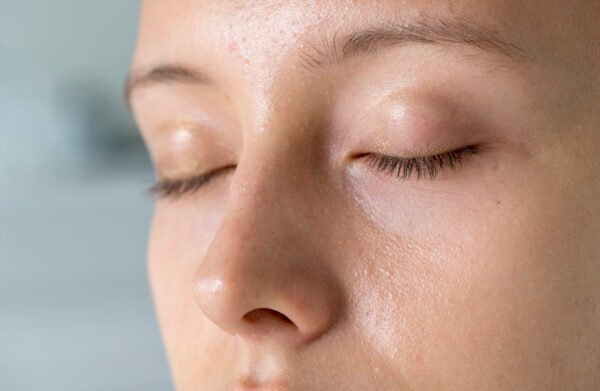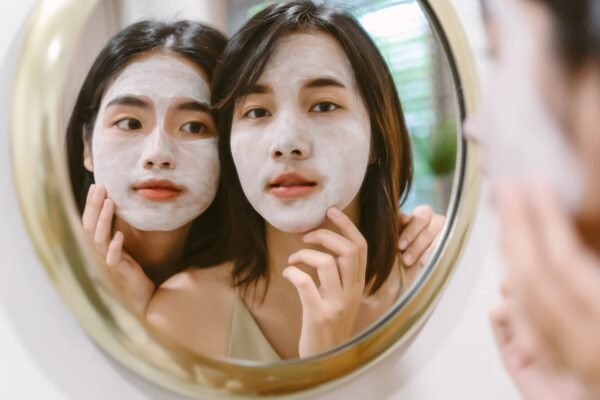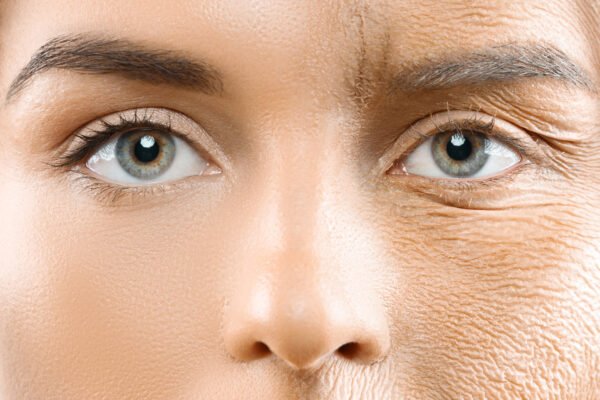Introduction
Overview of Oily Skin
Sebum, the skin’s natural oil, is made in too large amounts in people with oily skin. This often makes the skin look shiny, especially in the T-zone (forehead, nose, and chin). These are some common signs of oily skin:
- Enlarged pores.
- A tendency for acne and blackheads.
- A greasy feel throughout the day.
Hormonal changes, genetics, and environmental factors such as humidity and pollution can influence this skin type.
Importance of a Natural Skincare Routine
A natural skincare program helps oily skin for several reasons. Natural products include fewer synthetic chemicals and additives that might aggravate greasy skin. Using natural substances, sebum production may be balanced without disturbing skin processes. Antioxidants, anti-inflammatories, and moisturizing chemicals are also included in natural skincare. This method keeps skin clean and reduces the chance of chemical reactions.
Understanding Oily Skin
Causes of Oily Skin
Oily skin results from the overproduction of sebum, produced by the natural oil sebaceous glands. Several factors contribute to this excess oil:
- Hormonal Changes: Hormonal fluctuations, such as puberty, menstruation, pregnancy, or menopause, can increase sebum production. Conditions like polycystic ovary syndrome (PCOS) also impact hormone levels, leading to oilier skin.
- Genetics: Your genetic makeup plays a significant role in determining your skin type. If your parents had oily skin, you’re also more likely to have it due to inherited tendencies towards increased oil production.
- Environmental Factors: External factors such as high humidity, pollution, and exposure to sunlight can exacerbate oiliness. Humid conditions increase sebum production, while pollutants can clog pores, leading to further oil buildup and potential acne.
Challenges of Oily Skin
Oily skin presents several challenges:
- Excess Sebum Production: The overproduction of sebum results in a greasy appearance and can make your skin feel oily throughout the day. This excess oil can lead to discomfort and a constant need to blot or wash your face.
- Potential for Acne: The excess oil can mix with dead skin cells and become trapped in pores, leading to the formation of acne, blackheads, and whiteheads. The oily environment can also foster the growth of acne-causing bacteria.
- Shine: Oily skin often leads to an unwanted shine, particularly in the T-zone area. This can make your skin look greasy and require frequent touch-ups with oil-absorbing products to maintain a matte appearance.
Cleansing
Benefits of Natural Cleansers
Natural cleaners are a gentle and effective way to deal with oily skin. Natural cleaners are less likely to strip the skin of vital oils or upset its natural balance than harsh chemical-based ones. This kindness helps to:
- Maintain Skin Balance: Natural cleansers clean without over-drying the skin, which can trigger more oil production.
- Reduce Irritation: They are less likely to cause irritation or allergic reactions, making them suitable for sensitive skin.
- Support Skin Health: Many natural ingredients contain vitamins and antioxidants that nourish and protect the skin.
Recommended Ingredients
When choosing natural cleansers for oily skin, consider the following ingredients:
- Tea Tree Oil: Known for its antibacterial and anti-inflammatory properties, it helps reduce acne-causing bacteria and calm inflammation. It also helps to control excess oil production.
- Witch Hazel: This natural astringent tightens the skin and reduces excess oil without stripping it. It also helps to soothe irritated skin and reduce the appearance of pores.
- Clay-Based Cleansers: Clay, such as bentonite or kaolin, absorbs excess oil and impurities from the skin. It provides a deep clean while helping to minimize the appearance of pores and prevent breakouts.
Cleansing Tips
To effectively manage oily skin, follow these cleansing tips:
- How Often to Cleanse: Cleanse your face twice daily—once in the morning and once before bed. This routine helps remove excess oil, dirt, and sweat accumulated throughout the day.
- Proper Techniques: Apply the cleanser using lukewarm water gently and circularly. Avoid using hot water, which can irritate and dry out the skin. Rinse thoroughly to ensure no residue is left, as a leftover cleanser can lead to clogged pores and breakouts.
- Avoid Over-Cleansing: Over-cleansing can strip the skin of natural oils, increasing oil production. Stick to the recommended twice-daily routine to maintain a balanced complexion.
Toning
Purpose of Toning
Toning is crucial in a natural skincare routine, particularly for oily skin. The primary purposes of toning include:
- Balancing Skin pH: Toners help to restore the skin’s natural pH balance after cleansing. This balance is essential for maintaining healthy skin and preventing excessive oil production.
- Minimizing Pores: Toners can tighten the appearance of pores, giving the skin a smoother and more refined texture. This helps reduce the risk of clogged pores and subsequent breakouts.
Natural Toners
When selecting natural toners for oily skin, consider the following options:
- Aloe Vera: Aloe vera has soothing and anti-inflammatory properties that calm irritated skin and reduce redness. It also helps to balance oil production while providing hydration without greasiness.
- Rose Water: Rose water is a natural astringent that tightens pores and refreshes the skin. It also has anti-inflammatory properties that can help reduce puffiness and redness.
- Green Tea: Green tea is rich in antioxidants and has anti-inflammatory effects. It helps control oil production and soothe the skin, making it an excellent choice for oily skin prone to acne.
Application Tips
To achieve the best results with natural toners, follow these application tips:
- Apply After Cleansing: Use toner immediately to ensure your skin is balanced and ready to absorb other skincare products.
- Use a Cotton Pad or Hands: Apply toner using a cotton pad or your hands. If using a cotton pad, gently sweep it across your face, avoiding the eye area. If using your hands, pat the toner onto your face and neck.
- Don’t Overapply: Use toner sparingly. Applying too much can lead to dryness or irritation. One to two applications per day after cleansing is typically sufficient.
- Allow to Dry Naturally: Let the toner dry on your skin naturally before applying other skincare products. This ensures that your skin fully absorbs the toner’s beneficial properties.
Moisturizing
Why Moisturizing is Important
Moisturizing is a crucial step in any skincare routine, even for those with oily skin. Here’s why:
- Hydration Needs: Oily skin still requires hydration to maintain a healthy balance. Proper hydration helps prevent the skin from overproducing oil in response to dryness, which can exacerbate oiliness and lead to breakouts.
- Skin Barrier Protection: Moisturizers help strengthen the skin’s natural barrier, protecting it from environmental aggressors and reducing the risk of irritation and inflammation.
- Maintaining Skin Health: Hydrated skin is more resilient and less prone to flakiness or excessive oiliness. Regular moisturizing helps keep the skin smooth and supple.
Natural Moisturizers
Natural moisturizers offer hydration without adding excess oil for those with oily skin. Consider these options:
- Jojoba Oil: Jojoba oil closely resembles the skin’s natural sebum, making it an excellent choice for balancing oil production. It moisturizes without clogging pores and helps regulate sebum levels.
- Aloe Vera Gel: Aloe vera gel is a lightweight, non-greasy option that soothes and hydrates skin. It also has anti-inflammatory properties, making it ideal for calming irritated skin.
- Hyaluronic Acid: Hyaluronic acid is known for retaining moisture without adding oil. It binds water to the skin, providing deep hydration and plumping the skin.
How to Choose the Right Moisturizer
When selecting a moisturizer for oily skin, keep the following tips in mind:
- Non-Comedogenic: Choose moisturizers labeled non-comedogenic, meaning they won’t clog pores. This helps prevent the formation of acne and blackheads.
- Lightweight Formulas: Opt for gel-based or water-based moisturizers rather than heavy creams. These lighter formulas provide hydration without the added greasiness.
- Ingredients to Avoid: Avoid moisturizers with heavy oils or alcohol, which can exacerbate oiliness and irritate the skin. Look for ingredients that are known for their balancing properties.
Incorporating these natural moisturizers into your routine lets you keep your oily skin hydrated and balanced, promoting a healthier and more comfortable complexion.
Exfoliating
Benefits of Exfoliation
Exfoliation is critical in maintaining healthy, glowing skin, especially for oily skin. Here’s why it’s beneficial:
- Removing Dead Skin Cells: Regular exfoliation helps slog off dead skin cells that can accumulate on the surface. This prevents the buildup that can lead to clogged pores and dull, rough skin.
- Preventing Clogged Pores: Exfoliation helps to reduce the likelihood of pore blockages, which can cause acne and blackheads, by clearing away dead skin cells and excess oil.
- Improving Skin Texture: Exfoliating smooths the skin’s surface, making it appear more even and radiant. It also enhances the absorption of other skincare products, maximizing their effectiveness.
Natural Exfoliants
For those seeking natural options, these exfoliants can be highly effective:
- Oatmeal: Oatmeal is gentle and soothing, making it ideal for sensitive skin. It contains natural saponins that help to cleanse the skin, while its fine texture provides gentle exfoliation.
- Sugar: Sugar is a popular choice due to its natural glycolic acid content, which helps to dissolve dead skin cells. Opt for granulated sugar for a more abrasive scrub or brown sugar for a gentler option.
- Coffee grounds provide robust exfoliation that helps to invigorate the skin. They also have antioxidant properties that can benefit the skin, though they may be too harsh for sensitive skin types.
Exfoliation Frequency
To achieve the best results from exfoliation without irritation, consider the following:
- General Rule: Exfoliating 2-3 times per week is sufficient for most skin types. This frequency helps to maintain skin clarity without over-exfoliating, which can lead to sensitivity and damage.
- Sensitive Skin: If you have sensitive skin, limit exfoliation to once a week to avoid potential irritation. Choose milder exfoliants and avoid over-scrubbing.
- Monitoring Skin Reaction: Pay attention to how your skin responds. If you notice increased redness or irritation, reduce the frequency of exfoliation and adjust your choice of exfoliant.
By incorporating these natural exfoliants into your skincare routine and following proper exfoliation practices, you can maintain a more transparent, smoother complexion and keep oily skin under control.
Spot Treatment
Targeted Solutions for Breakouts
Spot treatments can provide targeted relief when dealing with occasional pimples or acne. Here’s how to effectively address breakouts:
- Identify the Issue: Spot treatments are designed for localized application, targeting areas where pimples or acne appear. This helps to address the issue directly without affecting the surrounding skin.
- Apply Promptly: For best results, apply spot treatments when you notice a breakout. Early intervention can help reduce the severity and duration of the pimple.
- Avoid Overuse: Use spot treatments sparingly. Over-application can lead to dryness or irritation, potentially worsening the situation.
Natural Spot Treatments
Natural remedies can be highly effective for treating breakouts. Here are some recommended options:
- Tea Tree Oil: Known for its antimicrobial properties, it helps reduce inflammation and fight bacteria that cause acne. To prevent irritation, dilute it with a carrier oil (like jojoba or coconut oil) before applying it directly to the affected area.
- Honey: Honey has natural antibacterial and anti-inflammatory properties. Apply a small amount of raw honey directly to the pimple, leave it on for about 15-20 minutes, then rinse off. It helps to soothe the skin and reduce swelling.
- Witch Hazel: Witch hazel is a natural astringent that helps to tighten the skin and reduce inflammation. Apply witch hazel extract to the affected area using a cotton swab to help dry out the pimple and reduce redness.
These natural spot treatments can effectively relieve breakouts, helping to manage occasional pimples and acne without relying on harsh chemicals.
Additional Tips for Managing Oily Skin
Diet and Lifestyle
- Impact of Diet: Your skin’s oil production is greatly affected by diet. Refined carbs and sugars may increase oiliness and acne. For skin health, eat antioxidant-rich fruits, veggies, whole grains, and lean meats. Fish and flaxseed omega-3s control oil production and prevent inflammation.
- Hydration: Hydration is essential for oily skin. Consuming adequate water helps the skin retain moisture and reduce oil production. Hydrate with cucumbers, watermelon, and eight glasses of water every day.
- Stress Management: Stress may increase oil production and cause skin problems. Exercise, meditation, and hobbies reduce stress, and healthy stress management improves skin and general health.
Environmental Factors
- Weather: Hot and humid weather can increase oil production, making your skin feel greasier. To mitigate this, use oil-absorbing products like mattifying primers or blotting papers. Opt for lightweight, non-comedogenic skincare products to prevent clogging pores.
- Pollution: Exposure to environmental pollutants can exacerbate oily skin and lead to acne. Protect your skin using a daily cleanser to remove impurities, and apply a broad-spectrum sunscreen to shield it from harmful UV rays and pollutants. Incorporate antioxidants into your skincare routine to help combat environmental damage.
Addressing diet, hydration, stress, and environmental factors can help you better manage oily skin and maintain a healthier complexion.
DIY Natural Skincare Recipes
Homemade Cleanser Recipe
Ingredients:
- One tablespoon honey
- One tablespoon of coconut oil
- One teaspoon of lemon juice
Instructions:
- Mix Ingredients: In a small bowl, combine honey, coconut oil, and lemon juice.
- Apply: Gently massage the mixture onto your face using circular motions.
- Rinse: Rinse off with lukewarm water and pat dry with a clean towel.
Benefits: Honey is a natural antibacterial agent that helps cleanse and hydrate the skin, while coconut oil provides moisture. Lemon juice can help brighten the skin and reduce oiliness.
DIY Toner Recipe
Ingredients:
- 1/2 cup rose water
- 1/4 cup witch hazel
- One teaspoon of apple cider vinegar
Instructions:
- Combine Ingredients: Mix rose water, witch hazel, and apple cider vinegar in a small bottle.
- Shake: Shake well to blend the ingredients.
- Apply: Soak a cotton pad with the toner and apply it to your face after cleansing.
Benefits: Rose water soothes and hydrates, witch hazel tightens pores, and apple cider vinegar helps balance skin pH.
Natural Exfoliant Recipe
Ingredients:
- Two tablespoons oatmeal
- One tablespoon honey
- One teaspoon yogurt
Instructions:
- Prepare Oatmeal: Grind the oatmeal into a fine powder.
- Mix Ingredients: Combine the ground oatmeal, honey, and yogurt in a bowl.
- Apply: Gently massage the mixture onto your face in circular motions.
- Rinse: Rinse off with lukewarm water and follow with a moisturizer.
Benefits: Oatmeal soothes and gently exfoliates, honey hydrates, and yogurt provides lactic acid for mild exfoliation.
Homemade Moisturizer Recipe
Ingredients:
- Two tablespoons of aloe vera gel
- 1 tablespoon jojoba oil
- One tablespoon shea butter
Instructions:
- Melt Shea Butter: In a double boiler, melt shea butter until liquid.
- Combine: Remove from heat and mix in aloe vera gel and jojoba oil.
- Cool and Store: Allow the mixture to cool, then transfer to a clean jar for storage.
Benefits: Aloe vera soothes and hydrates, jojoba oil balances oil production, and shea butter provides deep moisture.
These DIY natural skincare recipes are simple yet effective for maintaining healthy, glowing skin. Adjust the ingredients based on your skin type and needs for the best results.
Conclusion
Recap of Key Points
Creating a natural skincare routine for oily skin involves several essential steps and considerations:
- Understanding Oily Skin: Recognizing the causes of oily skin, such as hormonal changes and environmental factors, is crucial for tailoring your skincare approach.
- Cleansing: Use natural cleansers like tea tree oil, witch hazel, and clay-based products to gently remove excess oil without stripping the skin.
- Toning: Incorporate natural toners like aloe vera, rose water, and green tea to balance the skin’s pH and minimize pores.
- Moisturizing: Even oily skin needs hydration. Opt for non-comedogenic natural moisturizers such as jojoba oil, aloe vera gel, and hyaluronic acid.
- Exfoliating: Regular exfoliation with natural exfoliants like oatmeal, sugar, and coffee grounds helps prevent clogged pores and removes dead skin cells.
- Spot Treatment: Address occasional breakouts with natural spot treatments such as tea tree oil, honey, and witch hazel.
- Additional Tips: To support overall skin health, maintain a balanced diet, stay hydrated, and manage environmental factors like weather and pollution.
Encouragement to Try
Oily skin benefits from mild, effective natural skincare that reduces irritation and promotes skin health. Simple DIY recipes using natural components may improve skin health.
Invitation for Feedback
Please share your natural skincare experiences. Has anybody tried the DIY recipes? What outcomes have you seen? Ask questions or share your natural skincare experience. Your tips may help others have better skin.







